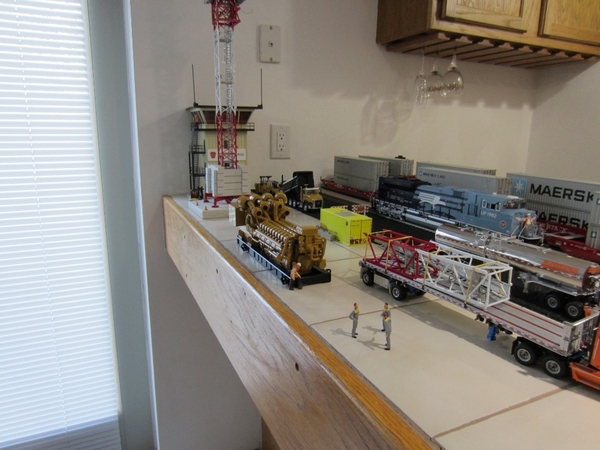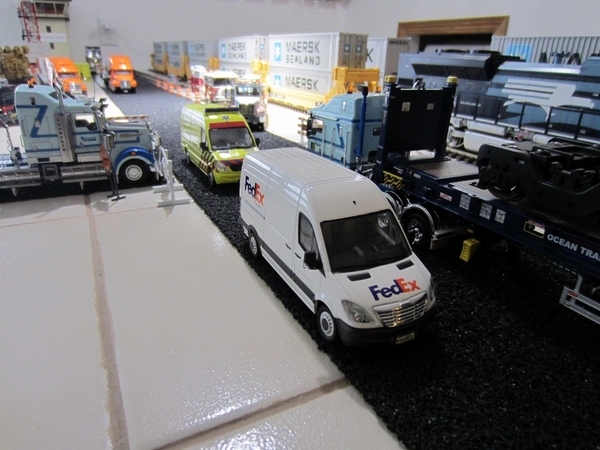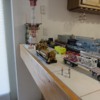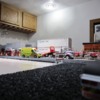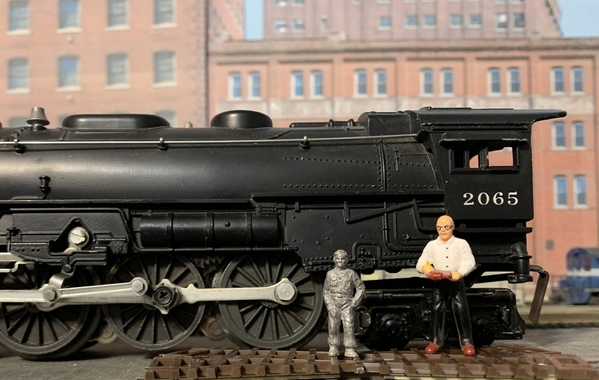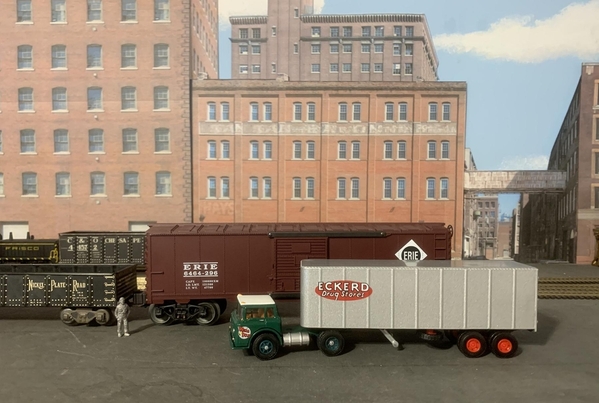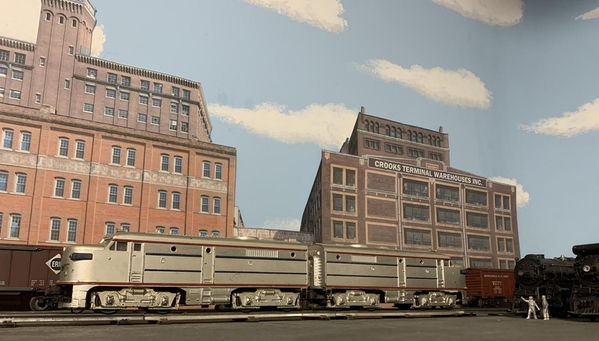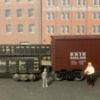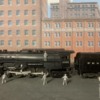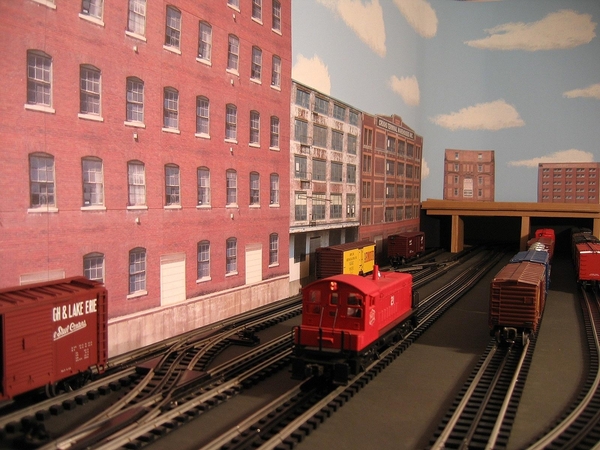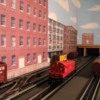Hello all, I am finishing up a 4x8 027 Lionel layout and what to add a few vehicles, i.e., police car, milk truck. However I don't know the correct scale to look for. I was told 1:43 scale. Is that correct? Thanks.
Replies sorted oldest to newest
Assume you are talking about postwar or postwar descendants. While 0 scale is 1:48, Lionel used selective compression on all its steam engines (773 which was never called 027 is an exception) and some of the diesels (all F3s and NW2s are very close to 1/48 scale). Even then there was no standard as the 2056, 2055, Hudsons were bigger than the 2025 2-6-2 and the even smaller 2026, 2018 2-6-4. The rolling stock was compressed as well (mostly) as even the top line aluminum passenger cars were close in with and height, but 4-5 inches short.
1/43 is way too big, even big for actual 0 of 1/48, but finding cars (not trucks) in 1/48 is near impossible. Since there is no true scale for 0-27 and 027 is much smaller than 1:48 use what looks best, my opinion would be 1:64. Maybe a little small, but better than towering over the trains.
I have found 1:55 to 1:64 works well depending on the size of the real vehicle.
thank you
Sorry I'm late to this thread. Many years ago I found a supplier of 1:50 construction equipment, and that looked great! 1:64 is "Hot Wheels" or Matchbox size and IMO too small with Lionels. On our childhood layout, we had the Plasticville cars (some had their wheels and bumpers painted to improve appearance), and 1970s Tootsietoy which were probably about 1:43. It's a shame that correctly proportioned cars are so hard to find.
Thanks. I have been banging my head against the wall trying to find the correct scale car that looks well.
Speaking of headbanging....
If you divide prototype standard gauge by O gauge (56.5" divided by 1.25") you get a scale of 1:45, or 17/64th inch = 1 foot. Not a very workable scale.
In the US, we went with 1/4" = 1 foot, or 1:48 scale, so our trains are a bit undersized.
In Europe, where the metric scale was more common, they adjusted it to 7mm = 1 foot, or 1:43.5 scale, so European trains are bit oversized.
As was mentioned, O27 trains are closer to S scale's 1:64 ratio. Matchbox cars were made to fit in a set sized box, so the scales varied from car to car - some are close to 1:64, most are smaller. Some Matchbox trucks are very close to HO 1:87 scale.
I believe many popularly available bus models are in 1/50, in addition to the previously mentioned construction equipment. A fellow in the UK, Modelu, seems to be adept at digital scale manipulation and 3d printing. You could contact him about printing 027 compatible people...
@PChepurko posted:Hello all, I am finishing up a 4x8 027 Lionel layout and what to add a few vehicles, i.e., police car, milk truck. However I don't know the correct scale to look for. I was told 1:43 scale. Is that correct? Thanks.
The right answer might be Plasticville - somewhere between "S" and "O".
George
It's possible to find a number of different kinds of trucks in 1/50 that look decent, made by Conrad or Corgi. Tonkin makes some 1/53 trucks. Matchbox is more 1/58 but can also look good depending on placement...
Mark
Choose vehicles that the 145 gateman can ride in. Or find something that looks right next to a 152 crossing gate or 154 flasher. ![]()
O27 engines and rolling stock are undersized and sizes vary, so chasing "scale" is a hopeless task. Go with whatever looks good to your eye.
Thak you all for the help.
@PChepurko posted:Hello all, I am finishing up a 4x8 027 Lionel layout and what to add a few vehicles, i.e., police car, milk truck. However I don't know the correct scale to look for. I was told 1:43 scale. Is that correct? Thanks.
Which era are you interested in? How much would you mind spending on each of these vehicles that you are interested in?
I buy 1:50 scale models of passenger vehicles, commercial trucks and construction equipment, that I see currently on or around the roads in the US.
Naveen Rajan
Attachments
Hello PC!
You have asked a question that can get complicated, depending on your own personal "Givens n' Druthers". (i.e. "Givens", as in things that can't be changed, versus your "Druthers", that is things you'd rather have, or your preferences.)
Your question is one I've pondered often and have even made some visual comparisons to help me settle the issue for myself.
First, let me make sure we're on the same page:
When you say "027", does that mean ONLY the rail specs OR do it also mean "traditional sized" type trains?
3-rail O "scale" is complicated significantly by the fact that many "traditional sized" trains have been downsized to better accommodate tight curves and such. Therefore, a 3-rail boxcar of "traditional size" proportions can be much smaller than an actual model made to 1/48, which is actual O "scale". Then there's the gauge itself: 3-rail gauge is about 5' gauge, whereas in the real world, "standard gauge" is 4' 8 1/2". The 5' gauge width can be noticeable at times.
What to do?
This is where you'll have to decide what you're willing to accept:
* IF you use "scale" (i.e. truly 1/48 scale) equipment (rail cars and locomotives) mixed among "traditional" sized equipment, then the scale equipment will often dwarf the traditional trains. The visual disparity may be off-putting to you.
* IF you decide to stay with all scale sized (true 1/48 proportioned) equipment, then your equipment is no longer a toy train enthusiast-type layout. It is now some form of "Hi-rail".
For me, I learned that for me to enjoy 3-rail, it would have to be with "traditional sized" trains and NOT 3-rail equipment of full 1/48 proportions. Further, I learned that I am not satisfied with the result of mixing 1/48 size equipment with "traditional" sized trains. Therefore, IF I were to ever have a 3-rail layout again, it is a case of "one or the other" and for me, I would prefer traditional trains for the latitude they bring to the table. ("Latitude": Smaller equipment so they can look better on tighter curves/etc.)
With that in mind, I started on a quest to see what would be the compromise in regards to figure sizes as well as vehicle sizes.
It didn't take long to immediately rule out 1/43 figures and vehicles. WAY too big (compared to the trains) to suit me.
Here's a quick comparison I did of a 1/43 figure and a 1/64 figure I had on hand next to a Lionel 2065. I used a piece of upside down HO track to put the figures at rail height level for a better comparison (reflecting a service area pad/etc.)
And here's a comparison picture of a 1/43 figure and 1/64 figure next to a Lionel 6464-type car. (A 6464 would be the largest traditional car I would use.)
Again, the 1/43 figure was way too big to be alongside traditional sized trains, in this case a Lionel 6464 boxcar and a Marx 1/64 scale 3-rail tinplate car.
Thus, I then began to further investigate using 1/64 (S scale) figures alongside the equipment. Here's some 1/64 figures alongside the 2065 engine:
Not bad at all. I then expanded my experiments to see what a 1/64 tractor-trailer would look like next to a 6464 boxcar:
Surprisingly, that looked very good to my eyes.
Therefore, I concluded that IF I ever came to the point that I would attempt another 3-rail layout, I would do so using select traditional 3-rail equipment. By "select", I mean I would avoid the Lionel postwar items that were offered that were very close to 1/48 scale (Lionel's NW2 switcher, Trainmaster locomotive, the F3 locomotive, etc) and strictly stay with equipment that was closer to 1/64 scale. (Most of their steam engines, the cast metal and stamp frame Alco FA carbody units, and such.)
This picture illustrates how nice the 1/64 figures look among two Lionel traditional steam engines (a 2065 and 2055) as well as some cast frame FA's. All of the elements work very well together proportionally and are "good enough" for my eyes.
SO... you may need to decide for yourself what you will accept and what you will not, then proceed accordingly.
I wish you the best!
Andre
Attachments
A follow up:
Here's my experimental 3-rail layout upon which I learned that mixing 1/48 w/traditional didn't work for me:
On the left is a full size 1/48 boxcar. The engine is a Railking SW, on the right is a cut of 6464 cars. (Far right track has 1/48 36' reefers.)
The traditional Railking switch engine was too small for 1/48 cars, but too big for 6464 type cars. The more I experimented and tried, the more I realized scale being mixed among traditional would not work for me.
Thus I canned the above approach and returned to scale 2 rail modeling, which is where I'm at today. (Via HO scale.)
If my eyesight/dexterity ever gets to the point that I need to make a change, I will then reconsider 3-rail, but with a traditional emphasis.
(Addendum: As long as the trains are traditional sized, I'm okay with the center rail: They're basically toy trains sitting in a scenic setting. IF I start trying to make my 3-rail effort more "scale" by using scale equipment, then the center rail really begins to bug me. I know, I weird.)
Again, best of luck to you!
Andre
Attachments
When dealing with 027 gauge track I go with proportion or how it looks when dealing with the trains and accessories like autos and trucks. Since most of my cars and engines are smallish 027 size I use smaller autos like S and HO to have the autos smaller than the rail cars and engines to put the emphasis on the railroad gear verses the autos. The same with Plasticville size buildings. The layout is about railroading and not buildings or autos.
Charlie
@Choo Choo Charlie posted:When dealing with 027 gauge track I go with proportion or how it looks when dealing with the trains and accessories like autos and trucks. Since most of my cars and engines are smallish 027 size I use smaller autos like S and HO to have the autos smaller than the rail cars and engines to put the emphasis on the railroad gear verses the autos. The same with Plasticville size buildings. The layout is about railroading and not buildings or autos.
Charlie
"The layout is about railroading and not buildings or autos."
True enough, but it is important to me for all things to be acceptably in proportion.
As for HO cars: Unless an HO car is being used in the background in a very well done "forced perspective" scene, HO size items among 027/traditional trains would never work for me.
Even as a child I could not stand to play with a truck that was one size and a car that was way too small or way too large. Just couldn't do it. Some of my friends could, but not me.
We each have to chart our own course and make our model train world please us personally. What works for one often will not work for another and vice versa.
Andre
In the 1930s, American Flyer made some nice "semi-scale" steam engines that ran on O gauge track, but were built to 1:64 scale. This way, folks could have realistic-looking engines running on small home layouts with sharp curves. After WW2, they changed to S scale, so both track and equipment were built to 1:64 scale.
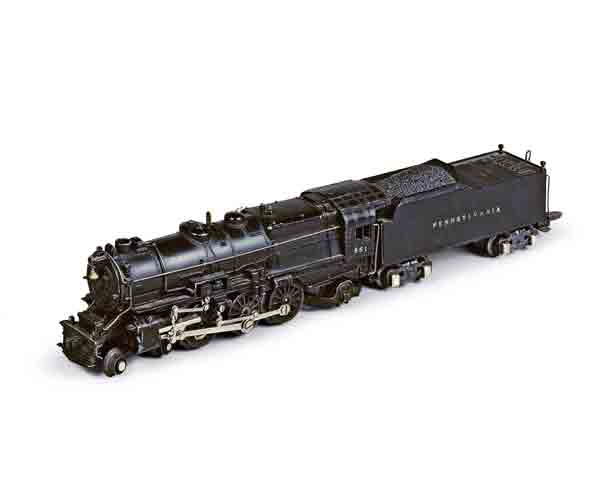
I don't have time right now to look thru my years worth of Christmas layouts so I'll post this one. I run exclusively O27 stuff and my vehicles are not 1:48 but to me they look fine. Since they are always shown with other vehicles of the same scale, that's the key.
- walt
For now, here are 2
Attachments
IMHO, 1:48, 1:50
For buildings I like Plasticville even though they are smaller. Why? Because they are nostalgic, don't take up a lot of space, and are easily bashed into unique buildings. Examples: Unique Plasticville Buildings (warrenvillerailroad.com)


